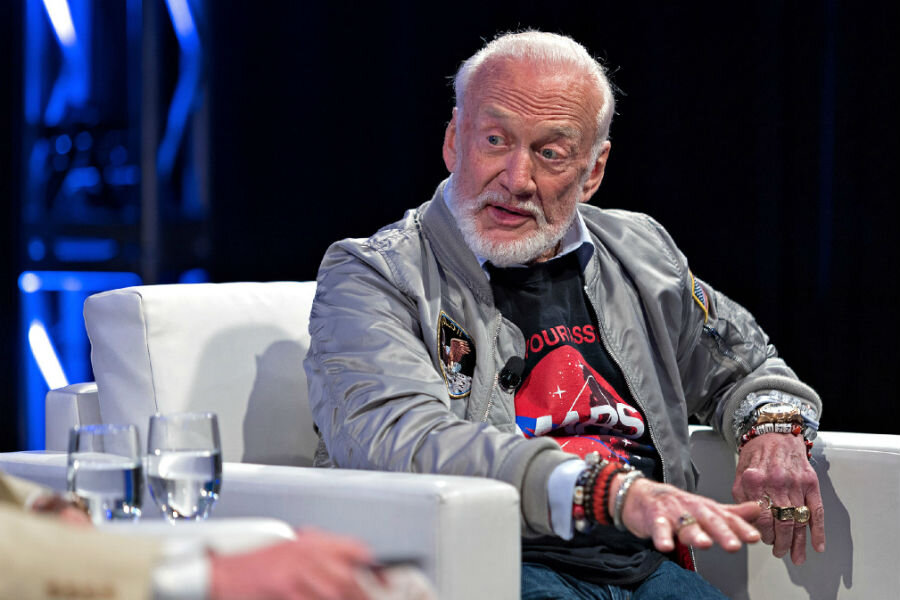Buzz Aldrin dreams of a colony on Mars: Could VR make it a reality?
Buzz Aldrin wants to establish a permanent colony on Mars – and he has a plan to make it happen. But bringing that plan to fruition requires communicating his vision to others.
Dr. Aldrin set out to do so at South by Southwest this week, describing a small but permanent colony of 150 residents on the planet. Unlike the one-way journeys proposed by some advocates of Mars colonization, he pictures prospective residents signing up for 10-year round trips. The moon, which made him a household name in 1969, features in his plan as a resupply station for the Mars colony.
On Tuesday, Aldrin revealed a new tool for sharing his dream: a 10-minute virtual reality immersion into life on the moon and Mars, produced in partnership with virtual reality company 8i and guided by Aldrin himself. By giving people the tools to "experience" the possibilities for themselves, he hopes to encourage enthusiasm for Mars exploration – something scientists say can only help.
“Anything that elevates people above the petty daily realm … is good,” says Paul Davies, a physics professor at Arizona State University who has written extensively about Mars colonization, in a phone interview with The Christian Science Monitor. “What Buzz Aldrin is doing, it’s inspiring.”
Many, including Aldrin, have been fascinated by Mars since around the time of the first moon landing. In the past few years, a journey to Mars has taken off in the public consciousness. NASA satellites have produced images of the planet’s surface, while rovers have collected soil samples and “sniffed” for life. The Obama administration set a goal of going to Mars – and returning humans safely to Earth – some time in the 2030s, while billionaire and SpaceX founder Elon Musk has released plans to create a self-sustaining city of 1 million people on the planet. And from “The Martian” to National Geographic’s MARS miniseries, it’s become ever easier for people to envision life on the red planet.
His status as the “second man on the Moon,” as well as his academic background, mean Aldrin is uniquely positioned to advocate for colonizing Mars. Aldrin’s stature “definitely” gives him a power to inspire enthusiasm that others lack, writes Dirk Schulze-Makuch, a professor at Washington State University’s School of the Environment, in an email to the Monitor.
Nor is this his first foray into virtual reality. A holographic image of Aldrin guided visitors to the Kennedy Space Center’s “Discover: Mars” exhibit, which ended in January.
“The opportunity to get up close and personal with a walk on Mars is so exciting,” said Therrin Protze, chief operating officer of the Kennedy Space Center Visitor Complex, in a press release. "We can’t wait for our guests to experience the thrill of it."
That exhibit closed on January 1, but Aldrin's new virtual reality experience can continue to bring the possibilities of Mars to a broader audience. It will be released on Friday through a number of VR providers.
The immersive tool provides a "great experience of almost being there … and that's going to be wonderful for expressing a number of ideas,” Aldrin told CNBC in an interview at South by Southwest.
But the challenge may not be – as Aldrin seems to suggest – inspiring recruits, Professor Schulze-Makuch says.
“When Paul Davies and I suggested the Mars One-Way Mission Concept many years ago, we had about 1,000 emails from people who wanted to volunteer – though we never asked for volunteers (and obviously did not have ourselves the means or technology)," he says.
“The missing ingredient is the money and political will.”
But virtual reality has proven itself as a fundraising tool for charities, helping them engage with key audiences in a meaningful way. Aldrin’s film could similarly help space-travel advocacy groups encourage Congress or private investors to fund a colony on Mars.
Professor Davies, however, is uncertain of the merits of this approach. NASA is an inherently conservative organization, he says, and there are simply too many risks for them to consider sending human missions at this point.
With that in mind, he says, the virtual reality experience is “going to be pretty marginal” in terms of its impact on public policy.
Even if NASA or some other entity were to agree, creating a self-sustaining community on Mars will likely take centuries, he says, adding that we currently have “very little idea of what it would take to have a self-sustaining ecosystem on Mars.”
For now, the virtual reality experience may inspire people to get involved with planning for such missions. Virtual reality is increasingly available in classrooms, Davies notes, describing a virtual field trip to a Mars-like environment in Australia in which his Arizona State students participate.
But it’s important that the possibilities of virtual reality not become more enticing than exploration itself, Schulze-Makuch points out.
“It might inspire many people, but it could also have the opposite effect, that people become content to experience it in virtual reality and not willing to undergo the hardships of spaceflight anymore,” he writes.









